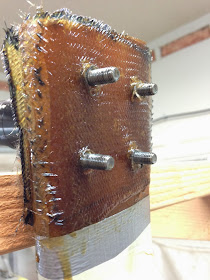Left leg toe-in final adjustment (3.0 hrs)
Drilling the axle holes through the left leg left me with a small dilemma... how to get the 4 bolts through the 6 layers of wet fiberglass I would need to add, without making a complete mess.
I decided to sharpen the same bolts I had cut (then recycled) when I worked on the landing brake hinge. I hoped I could use them to part the fiberglass neatly, thus avoiding unraveling the sticky mess.
 |
| After, during, and before. |
 |
| Test fit |
I ran a quick “proof of concept” test on a few layers of dry fiberglass scraps.
 |
| Splitting fibers |
In light of that resounding success, I decided to move on to “full scale implementation”, but first I glued the aluminum square back on the axle.
 |
| Hot glueing |
With the axle ready for action, I cut 6 plies of BID, and pre-pregged them into 2 “patches”.
 |
| 6 plies of BID |
 |
| Pre-preg patches ready for deployment |
I applied one patch to one side of the leg, then speared it from the opposite side with the bolts, in order to separate the fibers. I had to apply some pressure from the fiberglass side because it tended to lift up, but it eventually settled back down nicely.
 |
| Wet fiber splitting in action |
With the 4 holes parted on one side, I applied the other patch to the opposite side. Next, I ran the sharpened bolts back through the same holes, but in the opposite direction, repeating the fiber-separating procedure on the new patch.
 |
| Splitting fibers on the opposite side |
The sharpened bolt method worked out perfectly at separating the weave, dry and wet as you can see, and will be relied upon again in the future. The only thing to watch out for is when retracting the bolts, the tendency on the wet cloth is to pull a few fibers back through the hole to the other side. Not a problem really, just a minor annoyance.
With four clear paths through the gear leg, I installed the axle with temporary bolts.
 |
| Bolts made it easily through the wet mess |
Then, I installed the backing plate, cleaned up the threads with Acetone, and added a bunch of temporary washers and nuts.
Far from being over, the work was actually just beginning, as the delicate process of incrementally tightening the bolts, and repeatedly checking the toe-in got underway.
I was trying to achieve between 0.1” to 0.2ish” (2 to 6 mm) difference in measurement between centerline-to-axle, and centerline-to-aluminum-square distance.
I was very happy to see a little over 0.1” difference at the 21" mark, and let the setup cure overnight (I could not measure at the 24" mark due to the wooden structure I had erected).
 |
| B/2 distance in inches |
 |
| A/2 distance in inches |
 |
| Curing overnight |
All it’s needed now is some minor sanding, and a little trim where the brake caliper will go.
I’ll do that next time, but while I’m on the subject of brakes, I thought I’d share what I found when I looked a little closer at the brake pads...
 |
| Cracked brake pad |
 |
| Close up |
Yep! There is a crack right through the rivet! And no, they have not been dropped!
The guys at MATCO were very nice about it, and offered to replace the pad at no cost, which I’ll do soon.
Kudos to MATCO!

No comments:
Post a Comment